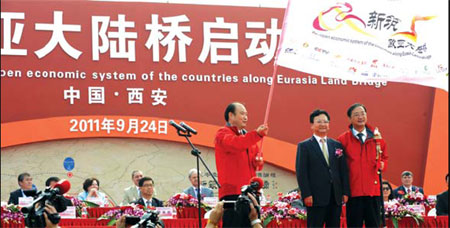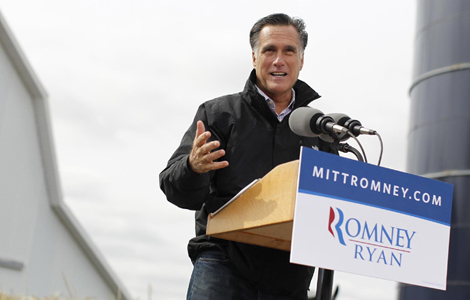Inland port helps link landlocked area to world
Updated: 2012-04-18 08:09
By Lu Hongyan (China Daily)
|
|||||||||||
|
Officials preside over the New Euro-Asia Bridge in September 2011. This event was an effort by the Xi'an International Trade and Logistics Park to extend the reach of Xi'an to Europe. |
When officials proposed in 2008 to turn Shaanxi's landlocked provincial capital into an international port, the idea met with opposition from the outset.
The argument against it seemed reasonable: Xi'an is not a coastal city, so how could it develop a port-driven economy?
But Han Song, deputy mayor of the city, was a firm supporter and strong advocate for this plan long before he was appointed to head two committees responsible for the Xi'an International Trade and Logistics Park, Xi'an's inland port area.
Han's idea was that the functions of a normal port, such as customs clearance, could be performed just as well inland, where there is convenient access to railway infrastructure. So he worked to realize his vision of building an international inland port.
The plan for developing the port was guided by Han's experience working at the Ministry of Commerce, the General Office of the State Council and the State Administration for Industry and Commerce.
"Thanks to the Xi'an International Trade and Logistics Park, all export-oriented enterprises in the northwestern region will no longer have to go to coastal ports to complete customs procedures, and in Xi'an, they could also enjoy all policy benefits, such as tax rebates. Furthermore, processing enterprises could move their production to this inland region," Han said.
"The international inland port is the core functional area of the Xi'an International Trade and Logistics Park. This will give Xi'an a strategic and competitive advantage over the course of its future development," the deputy mayor said.
But to become an inland port, easy and convenient transportation should be the first prerequisite, Han said.
To this end, the trade and logistics park has all the necessary qualifications since it enjoys the full support of the Xi'an railway container transport center, the Xi'an bonded logistics center and the Xi'an highway hub. And it has also established "strategic cooperative relations" with the major coastal ports in Shanghai; Tianjin; Qingdao and Rizhao in Shandong province; Lianyungang in Jiangsu province; and the border ports of Horgos and Alataw Pass in the Xinjiang Uygur autonomous region.
Broader cooperation
In 2010, when Zhao Leji, secretary of the Shaanxi provincial Party committee, made an inspection visit to the park, he called for "the great rejuvenation of the ancient Silk Road."
Han echoed Zhao and said the first step was to give Xi'an greater access to the oceans. "This is a long-held dream of all people of Shaanxi province and Xi'an." He then started working hard to make this dream come true.
In 2011, the Xi'an International Trade and Logistics Park, in cooperation with relevant departments of the Shanghai Cooperation Organization nations, organized the New Euro-Asia Bridge to extend the reach of Xi'an to Europe.
During the event, a special container named the Chang'an departed for Amsterdam from Xi'an to gather information on rail transport through the new Euro-Asia railway. Han Song led a convoy of vehicles to the same destination. During the 77-day journey of more than 16,000 kilometers, they visited 29 cities in eight countries, such as Kazakhstan, Russia, Turkey and the Netherlands.
The journey helped promote the trade and logistics park. It also tested the railway and highway transport systems, and helped push forward cooperation between China, Central Asia and Europe.
During the journey, the Xi'an International Trade and Logistics Park signed strategic cooperation agreements with the border ports of Alataw Pass and Horgos, established offices in Istanbul and Rotterdam, and showcased the economic development as well as the history and culture of Shaanxi and Xi'an to the world.
Extensive cooperation with Chinese and foreign ports ushered in a new era for Xi'an. "As the largest hub city on the Chinese section of the Euro-Asia railway bridge, Xi'an has proven to have all functions of an inland port, including free trade," Han said after the event.
Han said the development of Xi'an and its trade and logistics park may hold the key to the overall growth and development of China's inland regions.
But Han has a big picture in mind. "Acting as an international inland port is just a core function of the Xi'an International Trade and Logistics Park, or just one highly efficient engine to drive growth."
With the park as the foundation, "we plan to construct a new free trade zone oriented toward Central Asia, the Middle East and the European Union." When the goal is achieved, Xi'an will be a modern international city with a regional financial clearing center and an energy futures exchange.
Industrial development needs the support of integrated logistics services. The construction of an inland port will help optimize the city's industrial structure, aid its economic takeoff, attract more industries, and help improve the industrial competitiveness of the inland province and the northwest as whole.
"We are fully confident in the future of Xi'an, a prosperous, internationalized, modern and ecological city," Han said.
luhongyan@chinadaily.com.cn
(China Daily 04/18/2012 page7)
- One Chinese killed, over 100 detained in Ghana
- Sharp rise in online sabotage
- Growth downturn hits global firms
- Consuming challenge of food safety
- Ghana detains 100 Chinese for 'illegal' mining
- Mo's books flying off the shelves
- China's trade climbs in Sept amid bottoming-out
- Dispute drags down world economy
Hot Topics
CPC National Congress, Bogu Kailai, Diaoyu Islands, iPhone, Yao Ming, Sun Yang, Li Na, Liu Xiang, shenzhou, taiwan, hiv, school bus, house, hk, rare earth, food safety
Editor's Picks
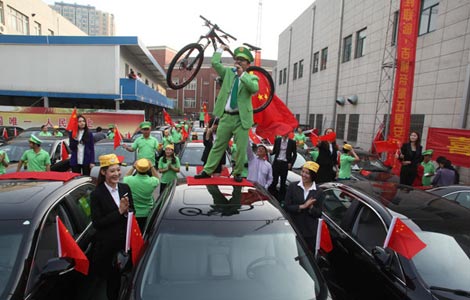
|

|
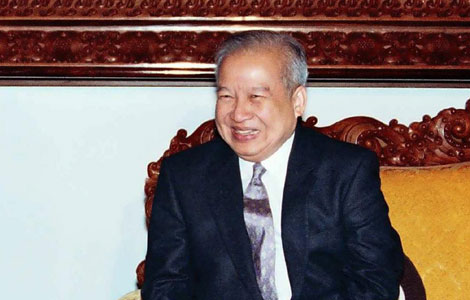
|
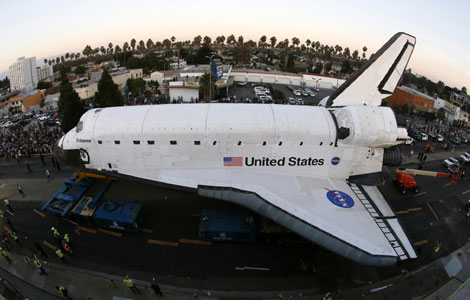
|

|

|
